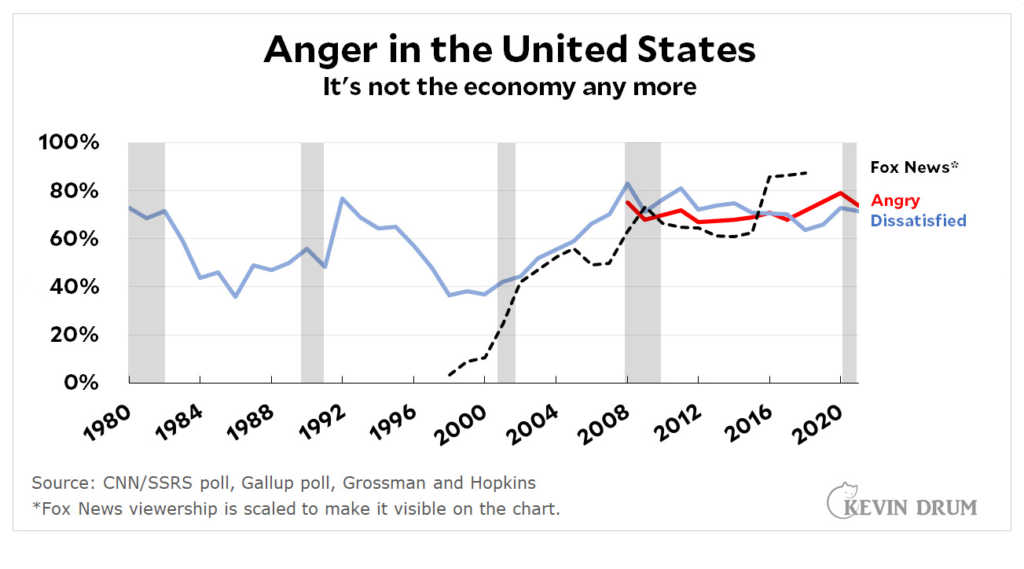
“Folks, advancing liberty and justice also requires protecting the rights of women. The constitutional right affirmed by Roe v. Wade, standing precedent for half a century, is under attack as never before.
If you want to go forward not backwards, we must protect access to healthcare; preserve a woman’s right to choose — and continue to advance maternal healthcare for all Americans.”
Image: CNN broadcast of State of the Union.
Neither Amy Coney Barrett, nor the five Republican men on the high court, are committed to preserving a woman's right to choose or advancing maternal healthcare. Instead, they are poised to strip away an array of rights that Americans (and not just women) have regarded as constitutionally protected. This judicial crusade seeks, by taking us backwards, to Make America Great Again. I use that phrase not to denote a special affinity with Donald Trump, but to highlight the commonality of the agenda of the court's majority with the retrograde policy preferences of the contemporary Republican Party and the cultural resentment that motivates the Republican base.
These justices are clawing back rights of individuals that the Supreme Court, the Congress, and the executive branch have recognized in decades past. Moreover, they are placing limits on the authority of the legislative and executive branches to enact and implement public policies that have been permitted in the past. Even the federal bench has not been spared the court's heavy hand.
As I've noted many times, the agenda of the 'conservative' court majority is more closely connected to the agenda of the contemporary Republican Party than it is to the Constitution, to any legal theories of constitutional or legislative interpretation (textualism, originalism, strict constructionism), or to traditional conservative judicial principles (judicial restraint, stare decisis, federalism). This is an activist court majority, which is crafting constitutional constraints to preclude policy choices by Democrats.
This project is of a piece with the efforts of Fidesz, Victor Orbán's political party, to disable democratic politics by forestalling public policy outcomes favored by its political opponents (as recounted in Jan-Werner Müller's What Is Populism?). Republicans have embraced this populist maneuver, which Müller describes in these words: "The populists' goal is to maintain power and, if they lose an election, to ensure that the victors will be hamstrung when trying to govern."
This court majority is ready, willing, and able to overrule the elected branches of the federal government with its own policy choices which, as a rule, match the policy preferences of the Republican Party. Beyond an antipathy toward Democratic choices, the Republican majority displays animosity to (small-d) democratic choices as well. The Republican justices' hostility toward voters, voting rights, and majority rule reinforces their partisan agenda.
The usual -- one more time
It is hardly difficult to make the case that the Republican justices are committed partisans, no matter how much they resist this characterization.
Stare decisis (Latin for 'to stand by things decided') suggests adherence to precedent. "Stare decisis is the preferred course because it promotes the evenhanded, predictable, and consistent development of legal principles, fosters reliance on judicial decisions, and contributes to the actual and perceived integrity of the judicial process." In its rush to rework the Constitution, conservatives have generated uncertainty, encouraged recurrent litigation, and obliterated settled law.
Justice Clarence Thomas was for it before he was against it. In 1991, when seeking confirmation before the Senate, he said “you cannot simply, because you have the votes, begin to change the rules, to change precedent.” By 2019, he said, “When faced with a demonstrably erroneous precedent, my rule is simple: We should not follow it.”
The quotations are from an amicus brief, filed in 2019 by Senator Sheldon Whitehouse, which noted that from October 2005 through October 2017, there were 78 5-4 (or 5-3) opinions in which the majority consisted solely of Republican-appointed justices:
With bare partisan majorities, the Court has influenced sensitive areas like voting rights, partisan gerrymandering, dark money, union power, regulation of pollution, corporate liability, and access to federal court, particularly regarding civil rights and discrimination in the workplace. Every single time, the corporate and Republican political interests prevailed.
The Republican majority has actively created new law to get its way. The liberal justices -- appointed by Democratic presidents -- have often referenced the disdain of the conservatives (that is, Republican-appointed) for stare decisis, now that they find themselves empowered as a majority.
Justice Stephen Breyer, in dissent:
It is far more dangerous to overrule a decision only because five Members of a later Court come to agree with earlier dissenters on a difficult legal question. The majority has surrendered to the temptation to overrule Hall even though it is a well-reasoned decision that has caused no serious practical problems in the four decades since we decided it. Today’s decision can only cause one to wonder which cases the Court will overrule next.
Justice Elena Kagan, in dissent:
Departures from stare decisis are supposed to be “exceptional action[s]” demanding “special justification,” Rumsey, 467 U. S., at 212—but the majority offers nothing like that here. In contrast to the vigor of its attack on Abood, the majority’s discussion of stare decisis barely limps to the finish line. And no wonder: The standard factors this Court considers when deciding to overrule a decision all cut one way. Abood’s legal underpinnings have not eroded over time: Abood is now, as it was when issued, consistent with this Court’s First Amendment law. Abood provided a workable standard for courts to apply. And Abood has generated enormous reliance interests. The majority has overruled Abood for no exceptional or special reason, but because it never liked the decision. It has overruled Abood because it wanted to.
Because it wanted to. I've posted many times about the Roberts Court's hostility to voting rights, a cause that buttresses Republican political fortunes when the party's preferred policies fail to secure popular support. John Roberts' obsession with gutting the 1965 Voting Rights Act began four decades ago during his career in the Reagan administration. He failed then, but succeeded in taking the first step in 2013, in Shelby County v. Holder by striking down the preclearance provision of the statute.
Justice Ruth Bader Ginsberg's dissent challenging the majority's logic -- in ruling that, since discrimination in voting had decreased since 1965, the law was no longer necessary -- is well known: "Throwing out preclearance when it has worked and is continuing to work to stop discriminatory changes is like throwing away your umbrella in a rainstorm because you are not getting wet."
Legal scholar and former Solicitor General Walter Dellinger (who passed away last month) described at the time the shamefully flimsy justification for that 2013 decision.
The first pillar of the decision is the “equal sovereignty of the states,” a constitutional principle that—as Judge Posner puts it with his customary precision—“does not exist.” As he says, “The opinion rests on air.”
The other basis for the court’s decision is the fact that the formula for deciding which states and municipalities are covered by Section 5 (and thus must go to the Department of Justice or court for pre-approval of a change to election law) is out-of-date. In the view of the court’s majority, the formula is not connected with sufficient logic to current acts of racial discrimination in voting. But there has never been a constitutional requirement that Congress act on up-to-date information or maintain a close logical nexus between problem and solution.
Congress is, in Dellinger's words, "constitutionally empowered to paint with a broad brush." He added that in Shelby County the majority never mentions the text of the 15th Amendment. The amendment consists of two sentences:
Section 1: The right of citizens of the United States to vote shall not be denied or abridged by the United States or by any State on account of race, color, or previous condition of servitude.
Section 2: Congress shall have the power to enforce this article by appropriate legislation.
So much for the conservatives' devotion to textualism. Instead of acknowledging the plain language of the amendment granting Congress authority to act, the justices rely on made-up, results-driven theories promoted by the Federalist Society. While this tact has the advantage of consistency with GOP objectives, it is a transparently shoddy contrivance.
A new day
My lament as a blogger: analytical reviews of decisions and dissents, of Constitutional provisions and legislative texts, and so on take time and thought and I'd like to be focusing on something else.
A recent piece by Ronald Brownstein ("The Supreme Court's 'Dead Hand'") suggests a more promising alternative for posts regarding the direction of the Supreme Court. Brownstein skips the legal skirmishing and shenanigans we're observing and, instead, takes a big picture look at the political realm in 21st century America. (In future posts, I hope to emulate this approach.) Brownstein begins:
The Supreme Court has set itself on a collision course with the forces of change in an inexorably diversifying America.
The six Republican-appointed Supreme Court justices have been nominated and confirmed by GOP presidents and senators representing the voters least exposed, and often most hostile, to the demographic and cultural changes remaking 21st-century American life. Now the GOP court majority is moving at an accelerating pace to impose that coalition’s preferences on issues such as abortion, voting rights, and affirmative action.
On all of these fronts, and others, the Republican justices are siding with what America has been—a mostly white, Christian, and heavily rural nation—over the urbanized, racially and religiously diverse country America is becoming.
What a great summary (with less muss and fuss than my typical posts), which opens to a discussion of the broader ramifications of the Republican jurists' campaign to take America back to an earlier age.
Comparing what's happening today with the antebellum years (when the court sided against attempts to stop the spread of slavery) and with the court's Lochner Era (when a conservative majority tried to smother FDR's economic agenda), Brownstein suggests that in each case an old guard was engaged in a "backward-facing crusade" against a burgeoning majority with different perspectives and preferences.
The Republican majority on the court represents a mostly white, Christian, rural America, which is determined to maintain dominance. These justices have set out to suppress the policy choices of a new majority of urbanized, racially and religiously diverse Americans. Brownstein's review suggests that (as in past eras) we may be in for a decades-long struggle between these two coalitions.
Yet another aspect of our democratic impasse.


